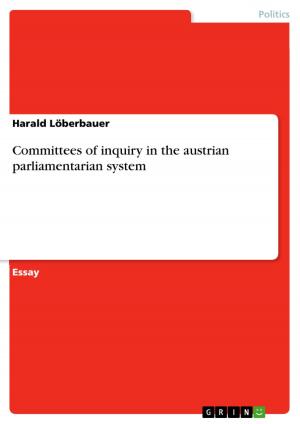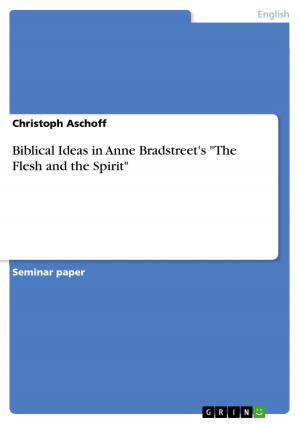The Concept of Metamorphosis in Literature
An investigation on Shakespeare's 'Midsummer Night's Dream'
Fiction & Literature, Literary Theory & Criticism, British| Author: | Karsten Löwer | ISBN: | 9783640634880 |
| Publisher: | GRIN Publishing | Publication: | June 1, 2010 |
| Imprint: | GRIN Publishing | Language: | English |
| Author: | Karsten Löwer |
| ISBN: | 9783640634880 |
| Publisher: | GRIN Publishing |
| Publication: | June 1, 2010 |
| Imprint: | GRIN Publishing |
| Language: | English |
Seminar paper from the year 2010 in the subject English Language and Literature Studies - Literature, grade: 1,0, Justus-Liebig-University Giessen (Institut für Anglistik), course: Literature and Metamorphosis, language: English, abstract: A Midsummer Night´s Dream (from here on in referred to simply as Midsummer), Shakespeare´s popular comedy about the fickleness and difficulty of love, has been written around 1594 and 1596, most likely as an entertainment piece for a royal festivity (Barber, 1959). An often cited and likely possibility for its first performance was the wedding reception of one Elizabeth Carey, a godchild of Queen Elizabeth I. to Thomas, son of Lord Berkely, which took place in February of 1596 (Holland, 1995). Still this remains speculative and it is not the only uncertainty surrounding Midsummer. Together with The Tempest and Love´s Labours Lost it is one few examples in Shakespeare´s canon in which no singular source text can be identified to serve as a basis for the poet´s interpretation. Although, as will be shown later it contains references to an array of literary texts, most famously Ovid´s Metamorphoses, not all aspects of its plot can be traced (Brown and Johnson, 2000). A case in point is the fairy realm and the fairies themselves. It appears that Shakespeare may have taken his cue from English, Irish and Germanic folk legends, which in some cases featured malicious fairies, but the idea of the tiny, winged and ultimately good-natured creatures, an image which has become lodged into popular consciousness ever since, did not exist in Shakespearian times and has thus been first conceived by Shakespeare himself (Pfeiffer, 1971). Furthermore the play is a composite of four individual strands of narration, artistically interweaved. Therefore, whereas for instance the royal realm represented by Theseus and Hippolyta, is derived from Greek mythology, the blending together of the four realms within a coherent narrative is an original Shakespearean formulation. The fact that Shakespeare does combine and blend together these different narrative strands, the mythical dimension with the physical reality of palace life, will be shown to correspond to the overriding theme of Midsummer: That of transformation and recombination, a proposition which will be investigated in the analysis presented here. [...]
Seminar paper from the year 2010 in the subject English Language and Literature Studies - Literature, grade: 1,0, Justus-Liebig-University Giessen (Institut für Anglistik), course: Literature and Metamorphosis, language: English, abstract: A Midsummer Night´s Dream (from here on in referred to simply as Midsummer), Shakespeare´s popular comedy about the fickleness and difficulty of love, has been written around 1594 and 1596, most likely as an entertainment piece for a royal festivity (Barber, 1959). An often cited and likely possibility for its first performance was the wedding reception of one Elizabeth Carey, a godchild of Queen Elizabeth I. to Thomas, son of Lord Berkely, which took place in February of 1596 (Holland, 1995). Still this remains speculative and it is not the only uncertainty surrounding Midsummer. Together with The Tempest and Love´s Labours Lost it is one few examples in Shakespeare´s canon in which no singular source text can be identified to serve as a basis for the poet´s interpretation. Although, as will be shown later it contains references to an array of literary texts, most famously Ovid´s Metamorphoses, not all aspects of its plot can be traced (Brown and Johnson, 2000). A case in point is the fairy realm and the fairies themselves. It appears that Shakespeare may have taken his cue from English, Irish and Germanic folk legends, which in some cases featured malicious fairies, but the idea of the tiny, winged and ultimately good-natured creatures, an image which has become lodged into popular consciousness ever since, did not exist in Shakespearian times and has thus been first conceived by Shakespeare himself (Pfeiffer, 1971). Furthermore the play is a composite of four individual strands of narration, artistically interweaved. Therefore, whereas for instance the royal realm represented by Theseus and Hippolyta, is derived from Greek mythology, the blending together of the four realms within a coherent narrative is an original Shakespearean formulation. The fact that Shakespeare does combine and blend together these different narrative strands, the mythical dimension with the physical reality of palace life, will be shown to correspond to the overriding theme of Midsummer: That of transformation and recombination, a proposition which will be investigated in the analysis presented here. [...]















